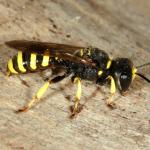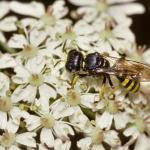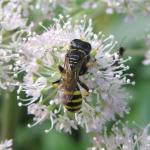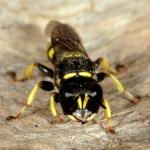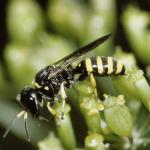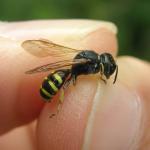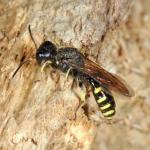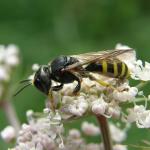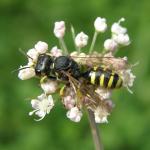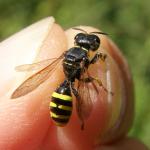Crabro argenteus (SCHENCK,1857); Ceratocolus fasciatus (LEPELETIER & BRULLÉ,1835); Crabro intermedius (MORAWITZ,1866); Crabro kollari (DAHLBOM,1845); Crabro luxuriosus (COSTA,1871); Solenius petiolatus (LEPELETIER & BRULLÉ,1835); Ceratocolus [lapsus] reticulatus (LEPELETIER & BRULLÉ,1835); Crabro vestitus (SMITH,1858)
A medium-sized species of Ectemnius.
Most records are restricted to southern England south of a line connecting the Bristol Channel with the Wash. North of this area, a few recent records exist for Herefordshire and Anglesey whilst older ones are from Lincolnshire, Cheshire and South-west Yorkshire. The overall picture is of a southern thermophilic species, with a rather striking abruptness in its northern limits. It does not show the apparent increase in frequency in northern England exhibited by some other Ectemnius species in recent decades. However, Spooner (unpublished notes) suggests that its frequency within southern England has increased during the course of this century. Recent records exist for the Channel Islands (Jersey), but it is unknown from Ireland. Overseas distribution confined to Europe (but not the far north), and the Caucasus.
This species is not regarded as being threatened.
Occurs in a variety of habitats but perhaps especially woodlands. Typically encountered around dead wood, timber and umbellifer flowers.
Univoltine; June to September with a distinct peak in August and early September, which is somewhat later than other Ectemnius.
Nest cells are stocked with medium-sized flies such as calypterates.
This wasp nests in burrows in a variety of dead wood including tree stumps and fence posts.
Umbellifers, especially wild angelica, also wild parsnip, hedge-parsley, hogweed and greater bumet-saxifrage.
None known, but likely to include anthomyiid and sarcophagid flies.
1998


